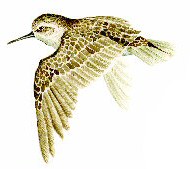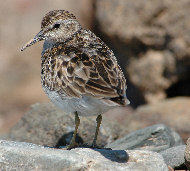

 |
 |
Semipalmated Sandpiper |
||
THE SEMIPALMATED SANDPIPER -“Shorebird of the mudflats”During the peak months of July and August, acrobatic flocks of thousands of birds mesmerize observers in the Bay of Fundy with their skill, majestic elegance and timelessness.Although twelve species of migratory shorebird commonly pass through the Bay of Fundy during fall, by far most of the visiting birds are Semipalmated Sandpiper (75%), Semipalmated Plover (20%) and Least Sandpiper. The Semipalmated Sandpiper, Calidris pusilla, is a small sparrow-sized shorebird which visits the upper Bay of Fundy annually from July through October. The term ‘semipalmated’ refers to this bird’s partially webbed feet. Over two million Semipalmated Sandpipers – roughly 75% of the world’s population -- move through the Fundy region en route from nesting grounds in the Canadian Sub-arctic to wintering areas in South America. By design, sandpipers return to the Bay of Fundy when food resources in
the mud flats are optimally available. Summer reinvigorates the mud flats
and the diverse community of creatures living in it. Notably, the abundance
of mudshrimp, Corophium volutator, is at its peak when sandpipers arrive
from the Sub-arctic. As well, the mudshrimp’s breeding season brings
these normally reclusive invertebrates to the mud’s surface in search
of mates. Millions of mudshrimp crawling about the surface of the mud --
what an ideal situation for hungry shorebirds. |
||
|
||
|
||
Whereas some shorebird species use a fly-stop-feed pattern of migration to return to South America, Semipalmated sandpipers complete their fall migration from the sub-Arctic to South America over a few long hauls. For migratory shorebirds, the stopover in Fundy is equivalent to filling up a gas tank before taking a long drive – the upper Bay of Fundy is the birds’ last stop before crossing over water. Consequently, while in Fundy, they must build the necessary fat stores to fuel the final -- and longest -- leg of their migration. With a tailwind, sandpipers attain an average speed of 90 km/hr and can complete the transoceanic flight from the Bay of Fundy to the north eastern coast of South America in an estimated 72 hours of non-stop flying. |
|
Up until the early 1900s, shorebirds did not receive legal protection in Canada or the United States and were hunted for their feathers and meat. Although less attractive to hunters than the larger species of shorebirds, sandpipers were considered a good eating bird, and when gathered in large migratory flocks, dozens could be easily taken with a single shot. Not surprisingly, severe hunting pressure caused steep population declines in shorebird abundances. Fortunately, Canada and the United States recognised the need to
co-operatively conserve transboundary bird species and, in 1916,
signed the Migratory Birds Convention. In the years following this
historic signing, shorebird received legal protection in both countries
and their populations rebounded.
|
|
|
Today, the health of global shorebird populations once again is matter of concern. The Semipalmated Sandpiper is one of several shorebird species whose population has been in moderate decline in recent years. Transcontinental migratory birds are vulnerable to a variety of factors across a broad geographic range. Factors implicated in the current population declines of shorebird species include human disturbance, hunting in wintering areas, habitat alteration or loss, chemical pollution, and climate change.
|
OTHER SHOREBIRDS OF FUNDYOver twenty different types of shorebird are known to move through Fundy either commonly or uncommonly. And because many of these birds are small and often rather indistinctive from one another in their markings, the task of identifying species can become challenging. Of the common species, Semipalmated Plovers, Charadrius semipalmatus, are easily distinguished from the sandpipers by their body markings. More difficult to separate from the Semipalmated Sandpipers, however, is the Least Sandpipers Calidris minutilla. Leg colour is the most obvious way to separate the two species: Semipalmated Sandpipers have black legs, whereas the Least Sandpiper has greenish-yellow legs. |
 
|
|
|
||
|
||
Text prepared by Nova Scotia Department of
Natural Resources (NSDNR) |